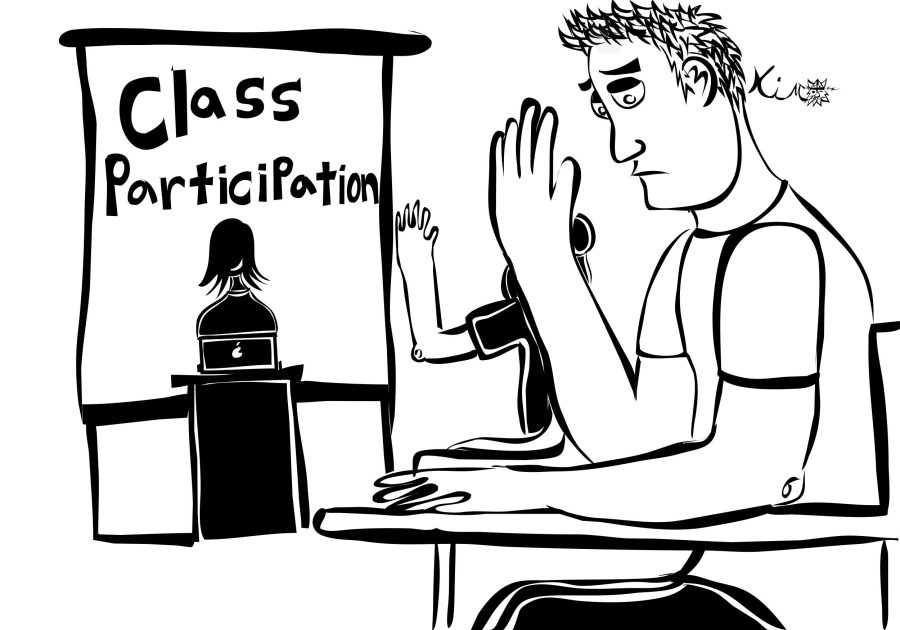Remember, this discussion is your last chance to raise your participation score before the end of the quarter.”
I watch as my English teacher calls on a student who has his hand raised high, stretching far into the air among a sea of desperate fingertips. As the student begins to speak, the teacher walks over to his computer and makes a click; the entire class is uncomfortably aware this student has just been rewarded with a participation point.
The emphasis on verbal participation in English courses becomes increasingly prominent as students enter high school, particularly once they reach sophomore year. However, it is encouraged in a manner that is not necessarily constructive to students’ learning.
Some teachers have opted to use ClassDojo, a website that allows them to assign positive or negative participation points to an individual each time they contribute to a class discussion. Although this system allows teachers to track student participation conveniently and efficiently, it keeps students constantly aware of the point-based system and forces unnatural participation, as many become overly preoccupied with their grades.
Rather than holding a spontaneous discussion where students are naturally willing to share insightful comments, students feel obligated to participate in order to earn one more participation point for every contribution if they want to receive a desirable participation grade. In this way, students are incentivized to speak solely for the purpose of earning participation credit, not for their ability to learn or think deeply.
Oftentimes, such an overwhelming percentage of the class will have their hands raised there is simply not enough time in the period for everyone to receive an opportunity to share.
“Since participation is such a big factor in our gradebook, everyone feels like they have to raise their hands all the time,” said junior Anna Oft. “The people who really wanted to share in a certain discussion might not have the chance to.”
Due to their constant need to participate, student deter their attention from understanding the content of the discussion to focusing on formulating a response that can earn them credit.
“I feel like when I participate now, it’s because I feel forced to do so,” Oft said.
Through this system, students are no longer as attentive to what their peers are contributing, which significantly takes away from the value of a class discussion, as listening to what others have to say is an opportunity to discover thoughts and analogies that may not have come to mind.
Additionally, requiring students to verbally participate should not be stressed as highly since not everyone is comfortable with voicing their ideas in front of the entire class.
“Some people are naturally more reserved and nervous to share their thoughts for fear of being wrong or judged,” said junior Lauren Daniel.
It is understandable that the pressure of having more than 20 peers listen to one’s contributions can be overwhelming, and that some may handle this task with more ease than others. While one student may raise their hand without thinking twice, another may feel obliged to practice what they are going to share multiple times in their head before obtaining the confidence to share in front of their peers.
“Students feel obligated to participate in order to earn one more participation points for every contribution if they want to receive a desirable participation grade.”
Common Core Standards in English Language Arts require teachers to incorporate speaking into their curriculum; however, English is not primarily a public speaking class and students should not be graded so harshly on their ability to share confidently in front of all of their classmates. It is important to recognize some students are more shy and prefer to engage through smaller group discussions. Creating an atmosphere that reflects a safe learning environment for everyone should be a top priority, which cannot be achievable if students are under pressure to do something that is out of their comfort zone.
“Personally, I do not usually speak a lot in class,” Daniel said. “It’s not because I don’t care, but because I’m not good at thinking on the spot when I’m talking in class.”
Participation is defined by involvement; completing class assignments thoroughly, doing the homework to the best of one’s ability, speaking when appropriate and staying on task should fulfill these requirements sufficiently. It is important for teachers to give students recognition for personal strengths and strive for a classroom environment where participation is encouraged naturally rather than it being incentivized by a grade.



